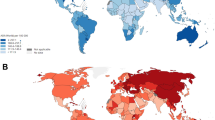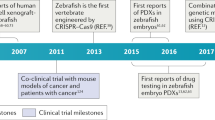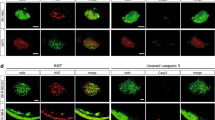Abstract
Zebrafish are making big waves in the field of cancer research. The effect has been widespread and continues to gain speed as more and more cancer researchers ride the wave of zebrafish biology. This has been largely due to the development of transgenic and xenograft models of cancer, which recapitulate many aspects of different human cancers including lymphoblastic T-cell leukemia, pancreatic cancer, melanoma and rhabdomyosarcoma. These models are already being utilized by academia and industry to search for genetic and chemical modifiers of cancer with success. The attention has been further stimulated by the amenability of zebrafish to pharmacological testing and the superior imaging properties of fish tissues that allow visualization of cancer progression and angiogenesis in live animals. This review summarizes the current zebrafish models of cancer and discusses their utility in human cancer research and future directions in the field.
This is a preview of subscription content, access via your institution
Access options
Subscribe to this journal
Receive 50 print issues and online access
$259.00 per year
only $5.18 per issue
Buy this article
- Purchase on Springer Link
- Instant access to full article PDF
Prices may be subject to local taxes which are calculated during checkout



Similar content being viewed by others
References
Ablooglu AJ, Kang J, Handin RI, Traver D, Shattil SJ . (2007). The zebrafish vitronectin receptor: characterization of integrin alphaV and beta3 expression patterns in early vertebrate development. Dev Dyn 236: 2268–2276.
Amatruda JF, Shepard JL, Stern HM, Zon LI . (2002). Zebrafish as a cancer model system. Cancer Cell 3: 229–231.
Amsterdam A, Sadler KC, Lai K, Farrington S, Bronson RT, Lees JA et al. (2004). Many ribosomal protein genes are cancer genes in zebrafish. PLoS Biol 2: E139.
Beckwith LG, Moore JL, Tsao-Wu GS, Harshbarger JC, Cheng KC . (2000). Ethylnitrosourea induces neoplasia in zebrafish (Danio rerio). Lab Invest 80: 379–385.
Beis D, Stainier DY . (2006). In vivo cell biology: following the zebrafish trend. Trends Cell Biol 16: 105–112.
Berghmans S, Jette C, Langenau D, Hsu K, Stewart R, Look T et al. (2005a). Making waves in cancer research: new models in the zebrafish. Biotechniques 39: 227–237.
Berghmans S, Murphey RD, Wienholds E, Neuberg D, Kutok JL, Fletcher CD et al. (2005b). tp53 mutant zebrafish develop malignant peripheral nerve sheath tumors. Proc Natl Acad Sci USA 102: 407–412.
Carmeliet P, Lampugnani MG, Moons L, Breviario F, Compernolle V, Bono F et al. (1999). Targeted deficiency or cytosolic truncation of the VE-cadherin gene in mice impairs VEGF-mediated endothelial survival and angiogenesis. Cell 198: 147–157.
Chen J, Jette C, Kanki JP, Aster JC, Look AT, Griffin JD . (2007). NOTCH1-induced T-cell leukemia in transgenic zebrafish. Leukemia 21: 462–471.
Clark EA, Golub TR, Lander ES, Hynes RO . (2000). Genomic analysis of metastasis reveals an essential role for RhoC. Nature 406: 532–535.
Faucherre A, Taylor GS, Overvoorde J, Dixon JE, Hertog JD . (2008). Zebrafish pten genes have overlapping and non-redundant functions in tumorigenesis and embryonic development. Oncogene 27: 1079–1086.
Feng H, Langenau DM, Madge JA, Quinkertz A, Gutierrez A, Neuberg DS et al. (2007). Heat-shock induction of T-cell lymphoma/leukaemia in conditional Cre/lox-regulated transgenic zebrafish. Br J Haematol 138: 169–175.
Friedl P, Bröcker EB . (2000). The biology of cell locomotion within three-dimensional extracellular matrix. Cell Mol Life Sci 57: 41–64.
Fukumura D, Jain RK . (2007). Tumor microvasculature and microenvironment: targets for anti-angiogenesis and normalization. Microvasc Res 74: 72–84.
Goessling W, North TE, Zon LI . (2007a). New waves of discovery: modeling cancer in zebrafish. J Clin Oncol 25: 2473–2479.
Goessling W, North TE, Zon LI . (2007b). Ultrasound biomicroscopy permits in vivo characterization of zebrafish liver tumors. Nat Methods 4: 551–553.
Hakem A, Sanchez-Sweatman O, You-Ten A, Duncan G, Wakeham A, Khokha R et al. (2005). RhoC is dispensable for embryogenesis and tumor initiation but essential for metastasis. Genes Dev 19: 1974–1979.
Haldi M, Ton C, Seng WL, McGrath P . (2005). Human melanoma cells transplanted into zebrafish proliferate, migrate, produce melanin, form masses and stimulate angiogenesis in zebrafish. Angiogenesis 9: 139–151.
Hall C, Flores MV, Storm T, Crosier K, Crosier P . (2007). The zebrafish lysozyme C promoter drives myeloid-specific expression in transgenic fish. BMC Dev Biol 7: 42–59.
Haramis AP, Hurlstone A, van der Velden Y, Begthel H, van den Born M, Offerhaus GJ et al. (2006). Adenomatous polyposis coli-deficient zebrafish are susceptible to digestive tract neoplasia. EMBO Rep 7: 444–449.
Her GM, Chiang CC, Chen WY, Wu JL . (2003). In vivo studies of liver-type fatty acid binding protein (L-FABP) gene expression in liver of transgenic zebrafish (Danio rerio). FEBS Lett 538: 125–133.
Isogai S, Lawson ND, Torrealday S, Horiguchi M, Weinstein BM . (2003). Angiogenic network formation in the developing vertebrate trunk. Development 130: 5281–5290.
Jain RK . (2002). Tumor angiogenesis and accessibility: role of vascular endothelial growth factor. Semin Oncol 29: 3–9.
Kari G, Rodeck U, Dicker AP . (2007). Zebrafish: an emerging model system for human disease and drug discovery. Clin Pharmacol Ther 82: 70–80.
Lam SH, Gong Z . (2006). Modeling liver cancer using zebrafish: a comparative oncogenomics approach. Cell Cycle 5: 573–577.
Lam SH, Wu YL, Vega VB, Miller LD, Spitsbergen J, Tong Y et al. (2006). Conservation of gene expression signatures between zebrafish and human liver tumors and tumor progression. Nat Biotechnol 24: 73–75.
Langenau DM, Feng H, Berghmans S, Kanki JP, Kutok JL, Look AT . (2005a). Cre/lox-regulated transgenic zebrafish model with conditional myc-induced T cell acute lymphoblastic leukemia. Proc Natl Acad Sci USA 102: 6068–6073.
Langenau DM, Ferrando AA, Traver D, Kutok JL, Hezel JP, Kanki JP et al. (2004). In vivo tracking of T cell development, ablation, and engraftment in transgenic zebrafish. Proc Natl Acad Sci USA 101: 7369–7374.
Langenau DM, Jette C, Berghmans S, Palomero T, Kanki JP, Kutok JL et al. (2005b). Suppression of apoptosis by bcl-2 overexpression in lymphoid cells of transgenic zebrafish. Blood 105: 3278–3285.
Langenau DM, Keefe MD, Storer NY, Guyon JR, Kutok JL, Le X et al. (2007). Effects of RAS on the genesis of embryonal rhabdomyosarcoma. Genes Dev 21: 1382–1395.
Langenau DM, Traver D, Ferrando AA, Kutok JL, Aster JC, Kanki JP et al. (2003). Myc-induced T cell leukemia in transgenic zebrafish. Science 299: 887–890.
Larson JD, Wadman SA, Chen E, Kerley L, Clark KJ, Eide M et al. (2004). Expression of VE-cadherin in zebrafish embryos: a new tool to evaluate vascular development. Dev Dyn 231: 204–213.
Le X, Langenau DM, Keefe MD, Kutok JL, Neuberg DS, Zon LI . (2007). Heat shock-inducible Cre/Lox approaches to induce diverse types of tumors and hyperplasia in transgenic zebrafish. Proc Natl Acad Sci USA 104: 9410–9415.
Lee LM, Seftor EA, Bonde G, Cornell RA, Hendrix MJ . (2005). The fate of human malignant melanoma cells transplanted into zebrafish embryos: assessment of migration and cell division in the absence of tumor formation. Dev Dyn 233: 1560–1570.
Mathias JR, Perrin BJ, Liu TX, Kanki J, Look AT, Huttenlocher A . (2006). Resolution of inflammation by retrograde chemotaxis of neutrophils in transgenic zebrafish. J Leukoc Biol 80: 1281–1288.
Mizgireuv IV, Majorova IG, Gorodinskaya VM, Khudoley VV, Revskoy SY . (2004). Carcinogenic effect of N-nitrosodimethylamine on diploid and triploid zebrafish (Danio rerio). Toxicol Pathol 5: 514–518.
Mizgireuv IV, Revskoy SY . (2006). Transplantable tumor lines generated in clonal zebrafish. Cancer Res 66: 3120–3125.
Mould AP, McLeish JA, Huxley-Jones J, Goonesinghe AC, Hurlstone AF, Boot-Handford RP et al. (2006). Identification of multiple integrin beta1 homologs in zebrafish (Danio rerio). BMC Cell Biology 7: 24–39.
Naumov GN, Akslen LA, Folkman J . (2006). Role of angiogenesis in human tumor dormancy: animal models of the angiogenic switch. Cell Cycle 5: 1779–1787.
Nicoli S, Ribatti D, Cotelli F, Presta M . (2007). Mammalian tumor xenografts induce neovascularization in zebrafish embryos. Cancer Res 67: 2927–2931.
Okihiro MS, Hinton DE . (1999). Progression of hepatic neoplasia in medaka (Oryzias latipes) exposed to diethylnitrosamine. Carcinogenesis 20: 933–940.
Parng C, Seng WL, Semino C, McGrath P . (2002). Zebrafish: a preclinical model for drug screening. Assay Drug Dev Technol 1: 41–48.
Patton EE, Widlund HR, Kutok JL, Kopani KR, Amatruda JF, Murphey RD et al. (2005). BRAF mutations are sufficient to promote nevi formation and cooperate with p53 in the genesis of melanoma. Curr Biol 15: 249–254.
Sabaawy HE, Azuma M, Embree LJ, Tsai HJ, Starost MF, Hickstein DD . (2006). TEL-AML1 transgenic zebrafish model of precursor B cell acute lymphoblastic leukemia. Proc Natl Acad Sci USA 103: 15166–15171.
Sahai E . (2007). Illuminating the metastatic process. Nat Rev Cancer 7: 737–749.
Shepard JL, Amatruda JF, Finkelstein D, Ziai J, Finley KR, Stern HM et al. (2007). A mutation in separase causes genome instability and increased susceptibility to epithelial cancer. Genes Dev 21: 55–59.
Shepard JL, Amatruda JF, Stern HM, Subramanian A, Finkelstein D, Ziai J et al. (2005). A zebrafish bmyb mutation causes genome instability and increased cancer susceptibility. Proc Natl Acad Sci USA 102: 13194–13199.
Smolowitz R, Hanley J, Richmond H . (2002). A three-year retrospective study of abdominal tumors in zebrafish maintained in an aquatic laboratory animal facility. Biol Bull 203: 265–266.
Spitsbergen J . (2007). Imaging neoplasia in zebrafish. Nat Methods 4: 548–549.
Spitsbergen JM, Tsai HW, Reddy A, Miller T, Arbogast D, Hendricks JD et al. (2000a). Neoplasia in zebrafish (Danio rerio) treated with N-methyl-N′-nitro-N-nitrosoguanidine by three exposure routes at different developmental stages. Toxicol Pathol 28: 716–725.
Spitsbergen JM, Tsai HW, Reddy A, Miller T, Arbogast D, Hendricks JD et al. (2000b). Neoplasia in zebrafish (Danio rerio) treated with 7,12-dimethylbenz[a]anthracene by two exposure routes at different developmental stages. Toxicol Pathol 28: 705–715.
Stern HM, Murphey RD, Shepard JL, Amatruda JF, Straub CT, Pfaff KL et al. (2005). Small molecules that delay S phase suppress a zebrafish bmyb mutant. Nat Chem Biol 1: 366–370.
Stern HM, Zon LI . (2003). Cancer genetics and drug discovery in the zebrafish. Nat Rev Cancer 3: 533–539.
Stoletov K, Montel V, Lester RD, Gonias SL, Klemke R . (2007). High-resolution imaging of the dynamic tumor cell vascular interface in transparent zebrafish. Proc Natl Acad Sci USA 104: 17406–17411.
Sun L, Zou Z, Collodi P, Xu F, Xu X, Zhao Q . (2005). Identification and characterization of a second fibronectin gene in zebrafish. Matrix Biol 24: 69–77.
Topczewska JM, Postovit LM, Margaryan NV, Sam A, Hess AR, Wheaton WW et al. (2006). Embryonic and tumorigenic pathways converge via Nodal signaling: role in melanoma aggressiveness. Nat Med 12: 925–932.
Wakamatsu Y, Pristyazhnyuk S, Kinoshita M, Tanaka M, Ozato K . (2001). The see-through medaka: a fish model that is transparent throughout life. Proc Natl Acad Sci USA 98: 10046–10050.
Wallace KN, Dolan AC, Seiler C, Smith EM, Yusuff S, Chaille-Arnold L et al. (2005). Mutation of smooth muscle myosin causes epithelial invasion and cystic expansion of the zebrafish intestine. Dev Cell 8: 717–726.
Wallez Y, Vilgrain I, Huber P . (2006). Angiogenesis: the VE-cadherin switch. Trends Cardiovasc Med 16: 55–59.
Wan H, Korzh S, Li Z, Mudumana SP, Korzh V, Jiang YJ et al. (2006). Analyses of pancreas development by generation of gfp transgenic zebrafish using an exocrine pancreas-specific elastaseA gene promoter. Exp Cell Res 312: 1526–1539.
White RM, Zon LI, Sessa A, Burke CJ, Bowman T, Leblanc J et al. (2008). Transparent adult zebrafish as a tool for in vivo transplantation analysis. Cell Stem Cell 2: 183–189.
Wolf K, Mazo I, Leung H, Engelke K, von Andrian UH, Deryugina EI et al. (2003). Compensation mechanism in tumor cell migration: mesenchymal–amoeboid transition after blocking of pericellular proteolysis. J Cell Biol 160: 267–277.
Yang HW, Kutok JL, Lee NH, Piao HY, Fletcher CD, Kanki JP et al. (2004). Targeted expression of human MYCN selectively causes pancreatic neuroendocrine tumors in transgenic zebrafish. Cancer Res 64: 7256–7562.
Zijlstra A, Mellor R, Panzarella G, Aimes RT, Hooper JD, Marchenko ND et al. (2002). A quantitative analysis of rate-limiting steps in the metastatic cascade using human-specific real-time polymerase chain reaction. Cancer Res 62: 7083–7092.
Acknowledgements
We thank Dr Mike Fried and Dr Tony Karnezis (UCSF), and Laurie Gay (UCSD) for critical reading of the paper. This work was supported by CBCRP postdoctoral fellowship no. 11FB-0088 (to KS) and NIH grants GM068487 and CA097022 (to RK). We also thank Dr Richard White for providing images of zebrafish casper mutant and discussion of its possible applications.
Author information
Authors and Affiliations
Corresponding author
Additional information
Supplementary Information accompanies the paper on the Oncogene website (http://www.nature.com/onc).
Supplementary information
Rights and permissions
About this article
Cite this article
Stoletov, K., Klemke, R. Catch of the day: zebrafish as a human cancer model. Oncogene 27, 4509–4520 (2008). https://doi.org/10.1038/onc.2008.95
Received:
Accepted:
Published:
Issue Date:
DOI: https://doi.org/10.1038/onc.2008.95
Keywords
This article is cited by
-
Anti-angiogenesis and anti-metastasis effects of Polyphyllin VII on Hepatocellular carcinoma cells in vitro and in vivo
Chinese Medicine (2021)
-
Edelfosine nanoemulsions inhibit tumor growth of triple negative breast cancer in zebrafish xenograft model
Scientific Reports (2021)
-
The use of zebrafish model in prostate cancer therapeutic development and discovery
Cancer Chemotherapy and Pharmacology (2021)
-
Long-term in vivo imaging reveals tumor-specific dissemination and captures host tumor interaction in zebrafish xenografts
Scientific Reports (2020)
-
Gelidiella acerosa inhibits lung cancer proliferation
BMC Complementary and Alternative Medicine (2018)



